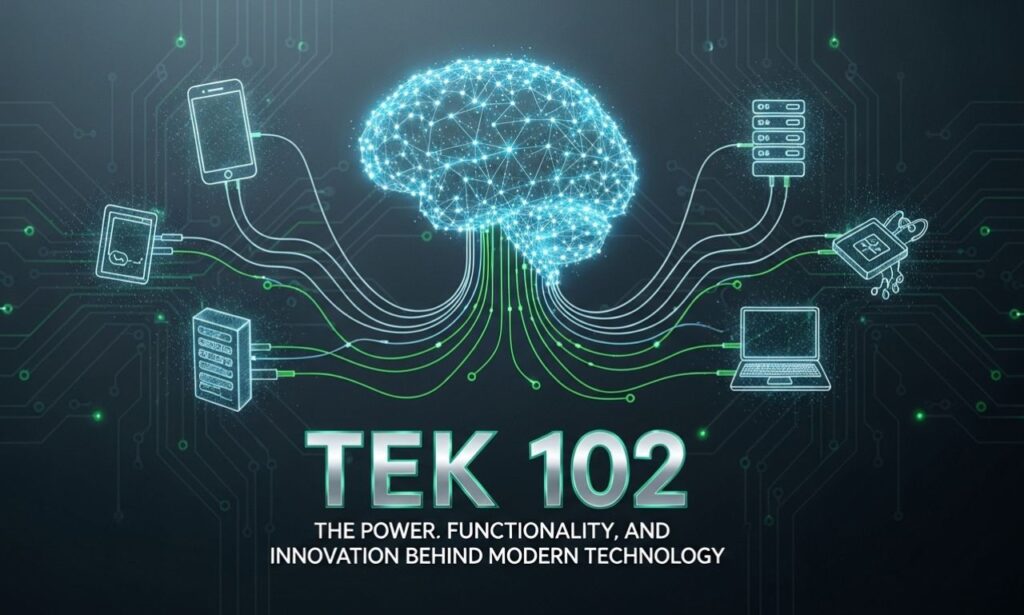In the modern era of technology, TEK 102 stands as a remarkable innovation symbolizing precision, performance, and next-generation design. Whether in electronics, industrial automation, or digital computing, has become synonymous with reliability and intelligent integration. This article delves deep into what means, how it works, and why it has become such an essential part of today’s digital infrastructure.
Understanding the Concept of TEK 102
The term TEK 102 generally refers to a technology model or component developed for advanced data processing and system integration. It is often used across various industries including computing, manufacturing, and digital communication. The main objective of is to enhance system efficiency while minimizing human error.
To understand more deeply, let’s look at its technical attributes, design philosophy, and how it is implemented across multiple sectors.
| Specification | Description |
|---|---|
| Model Name | TEK 102 |
| Type | Integrated Technology Module |
| Core Function | Data Processing & Control |
| Performance Level | High Efficiency & Accuracy |
| Applications | Industrial Automation, IoT Systems, Data Networks |
| Power Consumption | Optimized for Low Energy Use |
The table above summarizes the standard characteristics, giving insight into its adaptability and operational excellence.
The Evolution of TEK 102
Every technology has a developmental history, and TEK 102 is no exception. It was designed as an upgraded model to older TEK systems that lacked scalability and integration flexibility. Earlier versions focused solely on single-system control, while introduced a multi-environment interface.
The main evolution happened in three phases:
-
Development Stage: Research and prototyping to ensure data synchronization.
-
Implementation Stage: Integration with hardware and software systems.
-
Optimization Stage: Enhancing the module for low latency and energy efficiency.
This evolution made a cornerstone for digital manufacturing, AI-assisted processes, and smart home systems.
Core Features of TEK 102
The distinct advantage of TEK 102 lies in its structural and functional capabilities. It is not just another piece of hardware or software but a complete ecosystem that interacts seamlessly with other technological systems.
| Feature | Functionality |
|---|---|
| Adaptive Control | Allows self-adjustment in dynamic environments |
| Cloud Compatibility | Syncs with cloud-based applications for real-time data |
| Modular Design | Easy integration with existing setups |
| Energy Efficiency | Reduces power consumption without compromising output |
| Security Layer | Protects against unauthorized access |
Each feature makes stand out as a forward-thinking system that blends flexibility with intelligence.
Applications in Modern Industries
Industrial Automation and Robotics
One of the primary applications of is in industrial automation, where it helps coordinate machines, sensors, and control systems. The adaptive control algorithms enable smooth operations and predictive maintenance, minimizing downtime.
Information Technology and Cloud Computing
In the IT sector, TEK 102 plays a crucial role in managing complex data networks. It ensures quick data transmission, error-free processing, and scalable storage capabilities.
Healthcare and Diagnostics
Healthcare systems are becoming increasingly digital, and contributes through accurate monitoring systems and real-time medical data analysis.
Smart Home Integration
Home automation is another field where TEK 102 brings value. By connecting lighting, security, and entertainment systems, it creates a seamless living environment.
| Sector | Role of TEK 102 |
|---|---|
| Manufacturing | Robotics control and process optimization |
| IT & Cloud | Network synchronization and data analytics |
| Healthcare | Medical device automation |
| Home Automation | Smart connectivity and voice integration |
The versatility of is evident from its ability to adapt to multiple operational environments.
Technical Specifications of TEK 102
Technical specifications define how efficiently TEK 102 can perform across industries. Below is a breakdown of some essential parameters that determine its success.
| Parameter | Value/Description |
|---|---|
| Processor Type | Multi-Core Processor |
| Input Voltage | 3.3V to 5V |
| Communication Protocol | Ethernet / Wi-Fi / Bluetooth |
| Operating Temperature | -10°C to 70°C |
| Data Throughput | Up to 1.5 Gbps |
| Storage Capacity | Custom Configurable |
These specifications ensure that can handle high workloads, process complex computations, and maintain reliability even in demanding conditions.
Why TEK 102 Is Considered a Smart Technology
The intelligence behind lies in its adaptive learning and self-correcting mechanisms. It can process patterns, predict system behaviors, and adjust parameters automatically.
This smart functionality not only reduces human effort but also increases precision. Moreover, TEK 102 supports real-time monitoring and feedback, ensuring that systems are always operating at peak efficiency.
The integration of machine learning algorithms makes a game-changer in fields like automation, predictive analytics, and AI modeling.
TEK 102 vs Traditional Systems
To truly understand the power of TEK 102, it’s essential to compare it with older technologies.
| Aspect | TEK 102 | Traditional Systems |
|---|---|---|
| Efficiency | High, adaptive to workload | Moderate, manual control |
| Maintenance | Predictive and automated | Reactive and manual |
| Integration | Multi-platform support | Limited connectivity |
| Data Processing | Real-time and parallel | Sequential and slower |
| Security | Encrypted communication | Basic security protocols |
From this comparison, it’s evident that provides superior performance, flexibility, and security, making it the preferred choice for modern industries.
Benefits of Implementing TEK 102
The implementation of offers numerous benefits that go beyond technical improvement. It enhances organizational productivity, reduces costs, and strengthens operational accuracy.
Some key advantages include:
-
Improved data integrity and system reliability
-
Reduced downtime through predictive monitoring
-
Enhanced energy savings through efficient design
-
Seamless integration with cloud systems and IoT platforms
-
High return on investment for businesses adopting smart solutions
When implemented correctly, can transform an entire organization’s workflow and efficiency model.
Challenges and Limitations of TEK 102
Like any technological model, TEK 102 has certain limitations. Integration with legacy systems may require additional configurations, and high-end customization can be costly. Additionally, technical expertise is necessary for setup and calibration.
Despite these challenges, its long-term benefits outweigh initial deployment costs. Organizations that invest in enjoy reduced maintenance expenses and improved data accuracy over time.
Future Prospects of TEK 102
The future of TEK 102 looks bright with the rapid expansion of IoT, AI, and smart industry ecosystems. Its ability to handle autonomous operations will make it integral to 5G networks, smart cities, and renewable energy systems.
Upcoming versions may include enhanced neural processing units and self-diagnostic algorithms. As industries evolve, will continue to set benchmarks for efficiency, adaptability, and intelligence.
| Future Feature | Expected Benefit |
|---|---|
| AI-Driven Analytics | Improved decision-making |
| Quantum Integration | Faster computation speeds |
| Cloud Synchronization | Real-time global access |
| Eco-Friendly Design | Reduced carbon footprint |
How to Integrate into Your System
Integrating TEK 102 requires understanding both hardware and software compatibility. It begins with assessing system requirements, followed by selecting the correct configuration module. Once installed, calibration tools help align performance with operational objectives.
System integrators can connect to existing IoT devices, control panels, or data centers through Ethernet or wireless communication. Cloud management tools further allow remote monitoring and firmware updates.
Customer and Industry Reviews of TEK 102
Reviews from industries that use TEK reveal consistent satisfaction in terms of performance, adaptability, and reliability. Many users report lower energy costs and increased system responsiveness.
| User Type | Feedback Summary |
|---|---|
| Manufacturers | Enhanced production accuracy |
| IT Experts | Reliable network integration |
| Home Automation Users | Smooth device communication |
| Healthcare Engineers | Accurate real-time data capture |
These positive experiences demonstrate how contributes to both efficiency and sustainability.
Conclusion
In conclusion, TEK 102 is more than just a piece of advanced equipment—it’s a representation of the future of integrated technology. Its adaptability, intelligence, and performance capabilities make it a valuable asset across multiple industries.
From manufacturing automation to healthcare innovation, continues to redefine technological excellence. As technology continues to evolve, the presence of systems like ensures that efficiency, precision, and sustainability remain at the core of progress.






